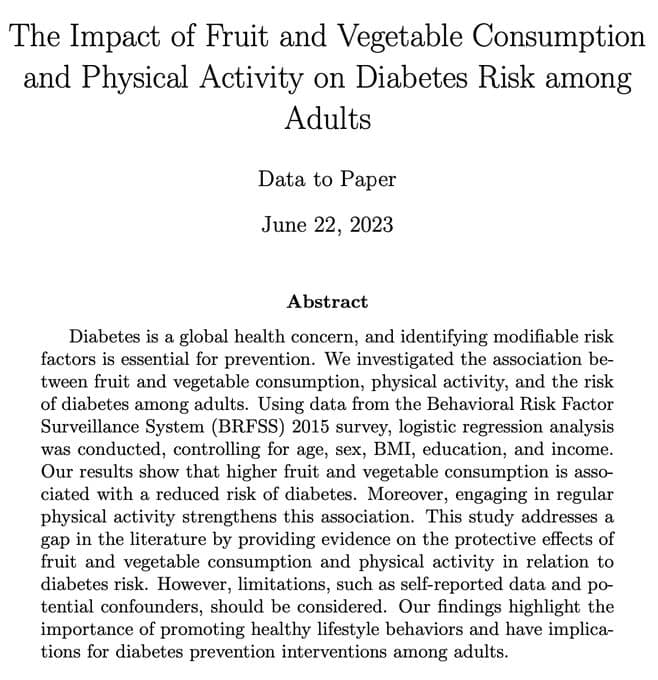Autonomous AI Research Platform “Data-to-Paper” Demonstrates Potential of ChatGPT in Scientific Analysis


In Brief
The “data-to-paper” autonomous AI research platform showcases ChatGPT’s capabilities in scientific analysis.
It uses a large CDC Health Survey dataset to explore various research topics, producing five transparent and reproducible papers.
The platform interacts with algorithmic agents, ensuring reproducibility and human involvement in the process.
An autonomous AI research platform called “Data-to-Paper” has recently been unveiled, showcasing the strong capabilities of ChatGPT in scientific analysis. Through a new approach, ChatGPT, a well-established language model, is utilized within this platform to autonomously generate research papers based on data analysis.

The process begins by feeding the ChatGPT model with a large CDC Health Survey dataset and allowing it to explore various research topics independently. After a brief period, the AI system selects several research areas, writes data analysis codes, interprets the obtained results, and ultimately produces five transparent and reproducible papers.
The feature of “data-to-paper” is its emphasis on reproducibility. The generated documents not only present the final outcomes but also include detailed technical steps and analysis codes employed by ChatGPT. This ensures that human scientists can review, follow, and reproduce the entire process accurately.

The platform operates through an intricate interaction between ChatGPT and algorithmic agents, each assuming different roles such as “scientist,” “reviewer,” “encoder,” and “illuminated reviewer.” These agents autonomously progress through the canonical sequence of research stages, from data analysis to the final paper.
To address potential challenges, such as hallucinated citations, the system has access to search engines. Additionally, auto-checks, cross-checks between multiple ChatGPT instances, and well-defined tasks are employed to minimize other instances of hallucination. Nonetheless, it is essential to acknowledge that the involvement of human judgment and assessment remains crucial for ensuring the quality of the resulting papers.
The “data-to-paper” platform is not a new language model but rather an orchestration of ChatGPT’s capabilities. Similar to other structured, automated approaches, such as AutoGPT and LangChain, it harnesses ChatGPT’s potential through a multi-step process focused on complex goals, specifically data analysis and paper writing.
One of the primary objectives of “data-to-paper” is to highlight the potential of ChatGPT in the scientific domain, traditionally considered a realm exclusive to human creativity and intellect. By provoking discussions around the strengths and societal impacts of current and future language models, the platform aims to stimulate new perspectives on the role of human scientists in this evolving era.
“Data-to-Paper” currently focuses on papers that involve statistical tests on datasets. However, expanding its capabilities to accommodate other types of data analysis studies remains a challenge, showing that the importance of human involvement and judgment in producing high-quality research papers cannot be understated.
The emergence of “data-to-paper” prompts us to consider how we can leverage interactive systems like a “scientist co-pilot.” Such systems can handle routine scientific tasks, enabling human scientists to engage in higher-level abstraction and tackle more complex questions and challenges. While there are areas for improvement, the platform undoubtedly opens up new avenues for exploration and collaboration in scientific research.
- MIT researchers conducted an experiment to evaluate GPT-4’s capabilities in various fields, including engineering, law, and history. The results showed GPT-4 demonstrated exceptional competence in various fields, but the claim of flawless 100% accuracy was not entirely accurate. The researchers used multiple methods to aid GPT-4 in answering questions accurately, including Chain of Reasoning, Coding Approach, Critical Prompt, and Expert Prompting. GPT-4 demonstrated a 90% success rate in solving the reserved 10% of questions without the aid of additional techniques. However, when employing these techniques, the model achieved a flawless 100% accuracy, flawlessly answering every question.
Read more about AI:
Disclaimer
In line with the Trust Project guidelines, please note that the information provided on this page is not intended to be and should not be interpreted as legal, tax, investment, financial, or any other form of advice. It is important to only invest what you can afford to lose and to seek independent financial advice if you have any doubts. For further information, we suggest referring to the terms and conditions as well as the help and support pages provided by the issuer or advertiser. MetaversePost is committed to accurate, unbiased reporting, but market conditions are subject to change without notice.
About The Author
Damir is the team leader, product manager, and editor at Metaverse Post, covering topics such as AI/ML, AGI, LLMs, Metaverse, and Web3-related fields. His articles attract a massive audience of over a million users every month. He appears to be an expert with 10 years of experience in SEO and digital marketing. Damir has been mentioned in Mashable, Wired, Cointelegraph, The New Yorker, Inside.com, Entrepreneur, BeInCrypto, and other publications. He travels between the UAE, Turkey, Russia, and the CIS as a digital nomad. Damir earned a bachelor's degree in physics, which he believes has given him the critical thinking skills needed to be successful in the ever-changing landscape of the internet.
More articles

Damir is the team leader, product manager, and editor at Metaverse Post, covering topics such as AI/ML, AGI, LLMs, Metaverse, and Web3-related fields. His articles attract a massive audience of over a million users every month. He appears to be an expert with 10 years of experience in SEO and digital marketing. Damir has been mentioned in Mashable, Wired, Cointelegraph, The New Yorker, Inside.com, Entrepreneur, BeInCrypto, and other publications. He travels between the UAE, Turkey, Russia, and the CIS as a digital nomad. Damir earned a bachelor's degree in physics, which he believes has given him the critical thinking skills needed to be successful in the ever-changing landscape of the internet.






















































